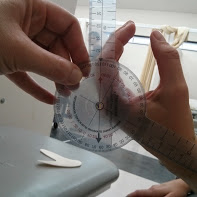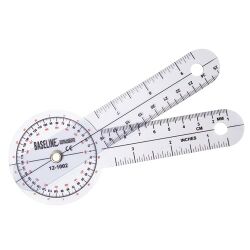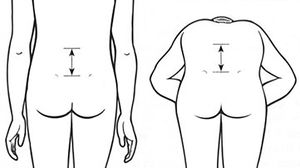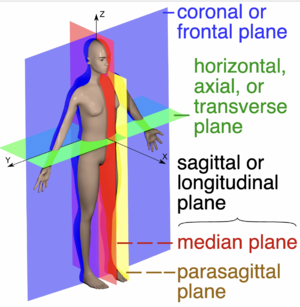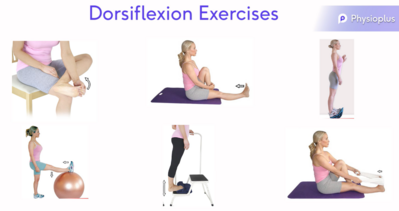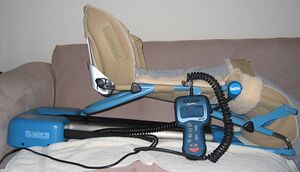Range of Motion: Difference between revisions
No edit summary |
No edit summary |
||
| Line 16: | Line 16: | ||
== Measuring Range of Motion == | == Measuring Range of Motion == | ||
[[File:Goniometer1.jpg|250x250px|Goniometer|alt=| | [[File:Goniometer1.jpg|250x250px|Goniometer|alt=|thumb]] | ||
ROM measurements are an integral part of the physiotherapy assessment since monitoring patient status and documenting patient progress are standard requirements of physiotherapy practice. The tool used may depend on the body part, ease of use and physiotherapist's experience. | ROM measurements are an integral part of the physiotherapy assessment since monitoring patient status and documenting patient progress are standard requirements of physiotherapy practice. The tool used may depend on the body part, ease of use and physiotherapist's experience. | ||
[[File:Schober Test.jpg|thumb|Schober Test]] | |||
A [[Goniometer]] is the most common tool for measuring range of motion of the joints of the body. It uses a stationary arm, fulcrum, and movement arm to measure joint angles from the axis of the joint.<ref>Gajdosik RL, Bohannon RW. [https://academic.oup.com/ptj/article-abstract/67/12/1867/2728156 Clinical measurement of range of motion: review of goniometry emphasizing reliability and validity.] Physical therapy 1987;67(12):1867-72.</ref> Making a ROM measurement by using a goniometer requires training for reliable results. See the [https://www.physio-pedia.com/Category:Goniometry goniometry] collection of pages for instructions on how to correctly (reliably and accurately) place the goniometer when measuring range of motion. | A [[Goniometer]] is the most common tool for measuring range of motion of the joints of the body. It uses a stationary arm, fulcrum, and movement arm to measure joint angles from the axis of the joint.<ref>Gajdosik RL, Bohannon RW. [https://academic.oup.com/ptj/article-abstract/67/12/1867/2728156 Clinical measurement of range of motion: review of goniometry emphasizing reliability and validity.] Physical therapy 1987;67(12):1867-72.</ref> Making a ROM measurement by using a goniometer requires training for reliable results. See the [https://www.physio-pedia.com/Category:Goniometry goniometry] collection of pages for instructions on how to correctly (reliably and accurately) place the goniometer when measuring range of motion. | ||
'''Other types of ROM measurement:''' Tape measures can also be used to measure range of motion in some specific parts of the body | '''Other types of ROM measurement:''' Tape measures can also be used to measure range of motion in some specific parts of the body. For example lumbar spine flexion can be assessed with a tape measure in the [[Schober Test]]. | ||
== Movement Planes == | == Movement Planes == | ||
When considering the range of motion of a joint, or the movement direction, | [[File:Cardinal Planes.png|thumb|Cardinal planes]] | ||
Three basic reference planes are used in anatomy. When considering the range of motion of a joint, or the movement direction, the three universal planes need to be taken into account. Each of the movements lie in one of the respective planes. <ref name=":2">Clarkson H.M. [https://dl.uswr.ac.ir/bitstream/Hannan/139276/1/9781609138165.pdf Principles and Methods. Musculoskeletal Assessment - Joint Motion and Muscle testing.] 3rd Edition. Philedelphia, USA. Lippincott Williams & Wilkins. 2013. p2-54.</ref> | |||
== Causes of Limited Range of Motion == | == Causes of Limited Range of Motion == | ||
Limited | Limited ROM refers to a joint that has a reduction in its ability to move. Motion may be limited because of a problem within the joint, swelling of tissue around the joint, stiffness of the muscles, or pain.<ref>Magee DJ. Primary care assessment. chap 17 [https://medlineplus.gov/ency/article/003173.htm <nowiki>''</nowiki>Limited range of motion] In: Magee DJ, ed. ''Orthopedic Physical Assessment''. 6th ed. St Louis, MO: Elsevier Saunders; 2014 </ref> | ||
Medical conditions associated with a limited range of motion in the joints include: | Medical conditions associated with a limited range of motion in the joints include: | ||
| Line 194: | Line 50: | ||
* Tight Clothing | * Tight Clothing | ||
* Hypertrophy of muscles due to strength training (e.g [[Biceps Brachii|biceps brachii]] hypertrophy limits the range of elbow flexion) | * Hypertrophy of muscles due to strength training (e.g [[Biceps Brachii|biceps brachii]] hypertrophy limits the range of elbow flexion) | ||
* Fat | * Fat | ||
== Increasing Range of Motion == | == Increasing Range of Motion == | ||
Range of motion can be maintained and gradually increased through the following range of motion & stretching exercises. Check out the page on [[Stretching]] for an in-depth explanation of the concept and topic. | Range of motion can be maintained and gradually increased through the following range of motion & stretching exercises. Check out the page on [[Stretching]] for an in-depth explanation of the concept and topic. | ||
| Line 255: | Line 84: | ||
* In pediatrics, ROM exercises are used when all or some of the normal physical activities are not able to be completed due to the physical condition of the child. Attention is given to the joint not being used through provision of active or passive ROM exercises. Passive ROM exercises can be performed by a family member or the healthcare provider. Active ROM exercises are performed by the child <ref>Nurse Key. [https://nursekey.com/range-of-motion-exercises/ ROM exercises] Available online: https://nursekey.com/range-of-motion-exercises/[accessed 25-10-2021]</ref>. | * In pediatrics, ROM exercises are used when all or some of the normal physical activities are not able to be completed due to the physical condition of the child. Attention is given to the joint not being used through provision of active or passive ROM exercises. Passive ROM exercises can be performed by a family member or the healthcare provider. Active ROM exercises are performed by the child <ref>Nurse Key. [https://nursekey.com/range-of-motion-exercises/ ROM exercises] Available online: https://nursekey.com/range-of-motion-exercises/[accessed 25-10-2021]</ref>. | ||
== | == International Classification of Functioning, Disability and Health (ICF) Category == | ||
[[Overview of ICF and Clinical Practice|ICF]] is a classification of health and health-related domains. This is the World Heath Organization (WHO) framework for measuring health and disability at individual and population levels. | |||
According to the ICF classification, range of motion (ROM) is classified as follows: | |||
b - Body functions > b7 - Neuromusculoskeletal and movement- related functions > | |||
'''b710 - Mobility of joint functions:''' functions of the range and ease of movement of a joint. | |||
- <u>Inclusions</u>: functions of mobility of single or several joints, vertebral, shoulder, elbow, wrist, hip, knee, ankle, small joints of hands and feet; mobility of joints generalized; impairments such as in hypermobility of joints, frozen joints, frozen shoulder, arthritis | |||
- <u>Exclusions</u>: stability of joint functions (b715); control of voluntary movement functions (b760) | |||
- Subcategories: | |||
'''b7100 - Mobility of a single joint:''' Functions of the range and ease of movement of one joint. | |||
'''b7101 - Mobility of several joints:''' Functions of the range and ease of movement of more than one joint. | |||
'''b7102 - Mobility of joints generalized:''' Functions of the range and ease of movement of joints throughout the body. | |||
'''b7108 - Mobility of joint functions, other specified''' | |||
'''b7109 - Mobility of joint functions, unspecified''' | |||
<ref>International Classification of Functioning, Disability and Health: ICF. Geneva: World Health Organization, 2001.</ref> | |||
== References == | == References == | ||
Revision as of 03:12, 20 November 2022
Original Editor - SULEIMAN USMAN Top Contributors - Angeliki Chorti, Lucinda hampton, SULEIMAN USMAN, Kapil Narale, Naomi O'Reilly, Shaimaa Eldib, Vidya Acharya, Shreya Pavaskar, Mariam Hashem, Kim Jackson and Leana Louw
Introduction[edit | edit source]
Range of motion (ROM) means the extent or limit to which a part of the body can be moved around a joint or a fixed point; the totality of movement a joint is capable of doing. Range of motion of a joint is gauged during passive ROM (assisted) or active ROM (independent)).
- ROM is usually assessed during a physical therapy assessment or treatment. Normal values depend on the body part, and individual variations.[1]
- The purpose of ROM exercises are prevention the development of adaptive muscle shortening, contractures, and shortening of the capsule, ligaments, and tendons. ROM exercises also provide sensory stimulation.[2][3]
Types of ROM[edit | edit source]
- Passive range of motion (PROM) is the ROM that is achieved when an outside force (such as a therapist or a CPM machine) exclusively causes movement of a joint and is usually the maximum range of motion that a joint can move. Usually performed when the patient is unable or not permitted to move the body part.
- Active-assisted range of motion (AAROM) is when the joint receives partial assistance from an outside force. Usually performed when the patient needs assistance with movement from an external force because of weakness, pain, or changes in muscle tone
- Active range of motion (AROM) is the ROM that can be achieved when opposing muscles contract and relax, resulting in joint movement. For example, the active range of motion to allow the elbow to bend requires the biceps to contract while the triceps muscle relaxes. Active range of motion is usually less than passive range of motion.[4] Usually performed by the patient independently and when the patient is able to voluntarily contract, control, and coordinate a movement.
Measuring Range of Motion[edit | edit source]
ROM measurements are an integral part of the physiotherapy assessment since monitoring patient status and documenting patient progress are standard requirements of physiotherapy practice. The tool used may depend on the body part, ease of use and physiotherapist's experience.
A Goniometer is the most common tool for measuring range of motion of the joints of the body. It uses a stationary arm, fulcrum, and movement arm to measure joint angles from the axis of the joint.[5] Making a ROM measurement by using a goniometer requires training for reliable results. See the goniometry collection of pages for instructions on how to correctly (reliably and accurately) place the goniometer when measuring range of motion.
Other types of ROM measurement: Tape measures can also be used to measure range of motion in some specific parts of the body. For example lumbar spine flexion can be assessed with a tape measure in the Schober Test.
Movement Planes[edit | edit source]
Three basic reference planes are used in anatomy. When considering the range of motion of a joint, or the movement direction, the three universal planes need to be taken into account. Each of the movements lie in one of the respective planes. [6]
Causes of Limited Range of Motion[edit | edit source]
Limited ROM refers to a joint that has a reduction in its ability to move. Motion may be limited because of a problem within the joint, swelling of tissue around the joint, stiffness of the muscles, or pain.[7]
Medical conditions associated with a limited range of motion in the joints include:
- Ankylosing Spondylitis
- Osteoarthritis (OA)
- Rheumatoid Arthritis (RA)
- Juvenile RA, which is an autoimmune form of arthritis that occurs in children under the age of 16 years
- Cerebral Palsy (CP)
- Legg-Calve-Perthes disease.
- Sepsis of the hip and other joints, which is a bacterial infection of the joints
- Congenital Torticollis
- Syphilis, which is a sexually transmitted infection (STI)
Other causes of restricted range of motion include:
- Inflammation of the soft tissues surrounding the joint, or joint swelling
- Muscle Stiffness
- Pain
- Joint Dislocation
- Fractures [8]
Other than pathological causes for restriction of movement, there could be non-pathological causes such as
- Tight Clothing
- Hypertrophy of muscles due to strength training (e.g biceps brachii hypertrophy limits the range of elbow flexion)
- Fat
Increasing Range of Motion[edit | edit source]
Range of motion can be maintained and gradually increased through the following range of motion & stretching exercises. Check out the page on Stretching for an in-depth explanation of the concept and topic.
Range of Motion Exercises & Stretching[edit | edit source]
Range of motion exercise refers to activity aimed at improving movement of a specific joint. This motion is influenced by several structures: configuration of bone surfaces within the joint, joint capsule, ligaments, tendons, and muscles acting on the joint.
There are three types of range of motion stretching exercises:
- Active Range of Motion (AROM): Movement of a joint provided entirely by the individual performing the exercise. In this case, there is no outside force aiding in the movement.
- Passive Range of Motion (PROM): Movement applied to a joint solely by another person or persons or a passive motion machine. When passive range of motion is applied, the joint of an individual receiving exercise is completely relaxed while the outside force moves the body part, such as a leg or arm, throughout the available range.
- Active Assisted Range of Motion (AAROM): Joint receives partial assistance from an outside force. This range of motion may result from the majority of motion applied by an exerciser or by the person or persons assisting the individual. It also may be a half-and-half effort on the joint from each source.
Physiotherapy[edit | edit source]
There are many reasons for seeing a Physiotherapist to aid with limited range of motion at a join. Range of motion therapy benefits include:
- Healing and recovery from soft tissue and joint lesions
- Maintaining existing joint and soft tissue mobility
- Minimizing the effects of contracture formation
- Preventing adhesions between myofascia
- Assisting neuromuscular reeducation
- Enhancing synovial movement [4].
Range of movement exercises can:
- Increase movement at a joint
- Increase the function of a joint, and the entire limb
- Improve movement efficiency
- Increase independence
- Decrease pain
- Improve and maintain joint integrity
Regaining range of motion in a joint is one of the first phases of injury rehabilitation. A physiotherapy assessment will be performed prior to prescribing a range of movement exercises. The assessment looks at the present range and the quality of the movement.
- Joints maintain a balanced range of motion by regular use and stretching of the surrounding soft tissues. Just 10 minutes of stretching three times a week can help improve range of motion.
- Quite often strengthening exercises are prescribed alongside or shortly after range of movement exercises as the increased movement at a joint without increasing the strength could cause a further injury [9].
- If the goal is to increase performance, the combination of foam rolling followed by stretching (but not vice versa) should be favored compared to stretching alone.[10]
- Continuous Passive Movement Machine (CPM) is also used to maintain and improve ROM. Physiotherapists may use this machine on post-operative patients (eg Total knee replacement patients). [12]
- In pediatrics, ROM exercises are used when all or some of the normal physical activities are not able to be completed due to the physical condition of the child. Attention is given to the joint not being used through provision of active or passive ROM exercises. Passive ROM exercises can be performed by a family member or the healthcare provider. Active ROM exercises are performed by the child [13].
International Classification of Functioning, Disability and Health (ICF) Category[edit | edit source]
ICF is a classification of health and health-related domains. This is the World Heath Organization (WHO) framework for measuring health and disability at individual and population levels.
According to the ICF classification, range of motion (ROM) is classified as follows:
b - Body functions > b7 - Neuromusculoskeletal and movement- related functions >
b710 - Mobility of joint functions: functions of the range and ease of movement of a joint.
- Inclusions: functions of mobility of single or several joints, vertebral, shoulder, elbow, wrist, hip, knee, ankle, small joints of hands and feet; mobility of joints generalized; impairments such as in hypermobility of joints, frozen joints, frozen shoulder, arthritis
- Exclusions: stability of joint functions (b715); control of voluntary movement functions (b760)
- Subcategories:
b7100 - Mobility of a single joint: Functions of the range and ease of movement of one joint.
b7101 - Mobility of several joints: Functions of the range and ease of movement of more than one joint.
b7102 - Mobility of joints generalized: Functions of the range and ease of movement of joints throughout the body.
b7108 - Mobility of joint functions, other specified
b7109 - Mobility of joint functions, unspecified
References[edit | edit source]
- ↑ Very well health What Is Range of Motion? Available:https://www.verywellhealth.com/overview-range-of-motion-2696650(accessed 20.11.2022)
- ↑ Access physiotherapy ROM Available:https://accessphysiotherapy.mhmedical.com/content.aspx?sectionid=86197210&bookid=1472 (accessed 20.11.2022)
- ↑ Abu El Kasem S., Aly S., Kamel E., Hussein H. Normal active range of motion of lower extremity joints of the healthy young adults in Cairo, Egypt. Bulletin of Faculty of Physical Therapy. 2020 Dec;25(1):1-7.
- ↑ 4.0 4.1 Hudson S. Rehabilitation Methods and Modalities for the Cat. In: Handbook of Veterinary Pain Management 2009 Jan 1 (pp. 538-577). Mosby. Available:https://www.sciencedirect.com/science/article/pii/B9780323046794100280 (accessed 25.10.2021)
- ↑ Gajdosik RL, Bohannon RW. Clinical measurement of range of motion: review of goniometry emphasizing reliability and validity. Physical therapy 1987;67(12):1867-72.
- ↑ Clarkson H.M. Principles and Methods. Musculoskeletal Assessment - Joint Motion and Muscle testing. 3rd Edition. Philedelphia, USA. Lippincott Williams & Wilkins. 2013. p2-54.
- ↑ Magee DJ. Primary care assessment. chap 17 ''Limited range of motion In: Magee DJ, ed. Orthopedic Physical Assessment. 6th ed. St Louis, MO: Elsevier Saunders; 2014
- ↑ Healthline What Is Limited Range of Motion? Available online:https://www.healthline.com/health/limited-range-of-motion [accessed 25-10-2021]
- ↑ Physio uk ROM exercises Available online: https://www.physio.co.uk/treatments/physiotherapy/range-of-movement-exercises.php[accessed 25-10-2021]
- ↑ Konrad A., Nakamura M., Bernsteiner D., Tilp M. The accumulated effects of foam rolling combined with stretching on range of motion and physical performance: a systematic review and meta-analysis. Journal of Sports Science & Medicine. 2021 Sep;20(3):535.
- ↑ Continuous Passive Motion Machine. Available online: https://commons.wikimedia.org/wiki/File:Continuous_Passive_Motion_Machine.jpg [accessed 15-11-2022]
- ↑ Samarpan Physiotherapy Clinic AHMEDABAD ROM Available online: https://samarpanphysioclinic.com/ [accessed 25.10.2021]
- ↑ Nurse Key. ROM exercises Available online: https://nursekey.com/range-of-motion-exercises/[accessed 25-10-2021]
- ↑ International Classification of Functioning, Disability and Health: ICF. Geneva: World Health Organization, 2001.
